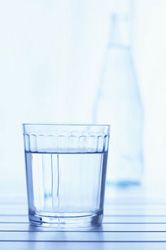New Data Shows Toxic PBDE Byproducts “Ubiquitous in U.S. Waters” -- What This Means for the Safety of YOUR Water
by www.SixWise.com
According to new research released by the Environmental Science & Technology, compounds released from widely used PBDE flame retardants can generate toxic dioxins when exposed to wastewater treatment. The combination of the dioxins and the compounds that produce them, hydroxylated PBDEs (OH-PBDEs), are turning up all along the U.S. Coastal waters and causing a negative impact on humans and aquatic creatures such as predatory fish and seals.

PBDEs are widely used as flame retardants in construction materials, textiles and home goods, and environmental concentrations have been doubling every four to six years. |
In order to cut down on the contamination of U.S. waters, researchers recommend changing the way PBDE-containing goods are disposed of as a way to decrease the amount landing in the consumer environment. Coming up with best practice guidelines for waste disposal could greatly alter future contamination levels along the U.S. shoreline for the better.
“Scientific evidence strongly documents that these contaminants impact the food web and action is needed to reduce the threats posted to aquatic resources and human health,” said John H. Dunnigan, assistant administrator of NOAA’s National Ocean Service in an Environmental Science & Technology article. “The report points out that laboratory toxicity studies have connected PBDEs to liver, thyroid, and neurobehavioral development impairments. It also says PBDEs show the potential for adverse human health effects.”
What Exactly are PBDEs?
PBDEs are a class of widely used brominated fire retardants that can be found in thousands of common consumer products. PBDEs have drawn the attention of environmentalists and scientists due to the growing evidence of its dangerous toxic effects. The danger of using PBDEs in certain products occurs in the manufacturing process. During the process they are mixed directly into the foam or plastic product instead of being chemically bound to the product thus increasing the chances they will leak out into the human environment.
Statistics show that 50 percent of the PBDEs that are used today worldwide are used in America.
Everyday Household Products That Contain PBDEs
- Plastics: Computers, televisions, hair dryers, curling irons, copy machines, fax machines, printers, coffee makers, plastic automotive parts, lighting panels, PVC wire and cables, electrical connectors, fuses, lamp sockets, smoke detectors
- Textiles: Back coatings and impregnation of home and office furniture, industrial drapes, carpets, automotive seating, aircraft and train seating
- Plyurethane foam: Home and office furniture, automobile, bus, plane and train seating, sound insulation panels, wood packaging materials
- Rubber: Conveyor belts, foamed pipes for insulation, rubber cables
- Paints and Lacquers: Marine and industry protective lacquers and paints
How Do PBDEs Enter Your Body?
The most common ways PBDEs make their way into the human body are through exposure to contaminated food, house dust and air.
Fish is considered to have the highest level of PBDEs. In the U.S. and Canada the levels of PBDEs from household dust, sewage sludge, wildlife and the environment was found to be 10 times higher than other industrialized nations. These findings strongly confirm that inhalation and ingestion of PBDEs from the environment are the main routes of exposure for those living in North America.
Researchers have also found an increasing amount of PBDEs in breast milk. Statistics showed that there was a 60-fold increase in the levels of PBDEs in breast milk between the years 1972-1997. In other words, the levels of PBDEs in breast milk are doubling every five years!
Animal studies revealed that it doesn’t take a whole lot of PBDEs during infancy to cause significant neurological damage and fetal malformation.
PBDEs have been linked to several other adverse health effects including:
Biomonitoring Needed in the U.S. for Accumulation of Chemicals in Humans
Currently the U.S. system for biomonitoring of chemical buildup in humans is lacking, particularly in times where industries are releasing millions of tons of chemicals into the environment and increasing exposure to humans. A solid biomonitoring system would serve as an early warning system to detect excess chemical buildup in human bodies, track trends, and take action with set regulation guidelines when needed.
Be a Smart Parent and Consumer by Limiting Your Exposure to PBDEs
Even if all of the toxic fire retardants were eliminated from our environment starting today, you would still be vulnerable to exposure through persistent pollutants that linger in your food, water and air. By making some lifestyle changes and diet you can minimize your exposure to dangerous toxins.
Got PURE Water?
 The Wellness Kitchen S-III combines the best filtration and enhancement technologies to deliver the purest and most natural tasting water available. It effectively reduces harmful contaminants, while at the same time enhancing the water with delicate ions and minerals.] The Wellness Kitchen S-III combines the best filtration and enhancement technologies to deliver the purest and most natural tasting water available. It effectively reduces harmful contaminants, while at the same time enhancing the water with delicate ions and minerals.]
- Replace any couches, stuffed chairs or automobile seats that have exposed foam.
- Replace old carpet padding and clean your home thoroughly once the padding is removed.
- Buy products with natural cotton and wood fibers. These are naturally fire resistant.
- Breastfeed your child. This is one way to ensure your child is getting the natural Omega-3 fatty acids that are not in infant formulas. It also supports infant development, particularly for bodies affected by PCBs and other harmful chemicals.
- Buy organic produce and stay away from processed foods as they contain chemical additives. Organic foods are free of dangerous pesticides and preservative chemicals.
- Instead of microwaving your food in plastic containers, use glass or ceramic containers.
- Let your faucet run for a while before filling your glass with water. This allows the filtering out of some common tap water pollutants.
- Stay away from red meats fatty dairy products as they contain high levels of certain pollutants.
- Cut back on the number of cosmetics and personal care products you use that may contain harmful chemicals.
- Avoid products with artificial fragrances and instead go fragrance-free.
- Go natural and use soap and water for cleaning instead of concentrated household cleaners.
- Try using manual or electrical tools before resorting to gasoline-powered tools.
- Avoid using stain repellants on your clothing, bedding and upholstery.
- Make sure your salmon is low in PCB and mercury contamination and avoid buying canned tuna as it contains mercury.
|
Sixwise.com also highly recommends you filter your home’s water using The Wellness Kitchen filtration system to remove not only PBDEs but also other contaminants.
The Wellness Kitchen combines the best filtration and enhancement technologies to deliver the purest and most natural tasting water available. It effectively reduces harmful contaminants, including chlorine and THMs, while at the same time enhancing the water with adding important yet delicate wellness "ions and minerals" that your body needs.
Because PBDEs are also found in household dust, it’s important to dust horizontal and other surfaces regularly -- but an ordinary dust cloth, the kind that just moves dust around, won't do.
What's the optimum choice for dusting? The PerfectClean line of mops, dusters, towels and more, which are used by leading hospitals and other healthcare organizations. Rather than just pushing dust around, or worse, stirring it up into the air, PerfectClean products are made with positively charged ultramicrofibers that pick up everything in their path -- including dust and all of its microscopic attachments. These ultramicrofibers are so small at an astonishing 3 microns that they're even smaller than most bacteria (each cleaning cloth contains over 300 miles of actual cleaning surface!). They pick up contaminants either used dry or dampened with water-no harsh cleaners needed.
Choosing PerfectClean's ultramicrofiber cloths, mops and wipes is by far the smartest choice -- and the most economical since each cloth can be used over 100 times before being replaced -- for dusting in your home.
Though it's impossible to not have ANY dust in your home, by dusting your home regularly with PerfectClean you will be able to keep dust, and therefore your risk of related illness, to a minimum.
Recommended Reading
Cancer-Causing Disinfection Byproducts: Are You Aware of These Toxins That Contaminate Virtually ALL U.S. Water Supplies?
Chlorine: The Dangers of This Common Chemical, and How You are Being Exposed
Sources
Environmental Science & Technology May 27, 2009
Environment News Service March 10, 2008
New Scientist January 2009
Environmental Working Group